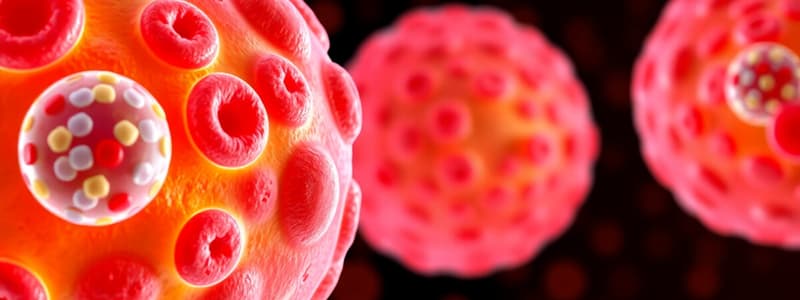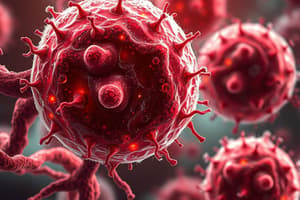Podcast
Questions and Answers
Which characteristic is most indicative of acute leukemia compared to chronic leukemia?
Which characteristic is most indicative of acute leukemia compared to chronic leukemia?
- Predominance of mature cells.
- Typically treated with non-curative therapies.
- Indolent clinical course.
- Presence of immature blast cells. (correct)
A patient presents with fatigue, dyspnea, and splenomegaly. These findings are MOST consistent with which category of hematologic neoplasm?
A patient presents with fatigue, dyspnea, and splenomegaly. These findings are MOST consistent with which category of hematologic neoplasm?
- Leukemia. (correct)
- Lymphoma.
- Myelodysplastic syndrome.
- Myeloproliferative neoplasms.
How does Hodgkin lymphoma typically differ from Non-Hodgkin lymphoma in terms of disease spread?
How does Hodgkin lymphoma typically differ from Non-Hodgkin lymphoma in terms of disease spread?
- Hodgkin lymphoma commonly presents with widespread involvement from the outset, while Non-Hodgkin lymphoma tends to remain localized.
- Hodgkin lymphoma often presents in a localized manner, whereas Non-Hodgkin lymphoma is commonly widespread. (correct)
- Hodgkin lymphoma is more frequently associated with B symptoms, whereas Non-Hodgkin lymphoma rarely presents with these symptoms.
- Hodgkin lymphoma is primarily a neoplasm of myeloid cells, while Non-Hodgkin lymphoma involves lymphoid cells.
What is the underlying mechanism in myelodysplastic syndromes (MDS) that leads to cytopenias?
What is the underlying mechanism in myelodysplastic syndromes (MDS) that leads to cytopenias?
Which of the following is the MOST prominent feature of myeloproliferative neoplasms?
Which of the following is the MOST prominent feature of myeloproliferative neoplasms?
The presence of Auer rods in a peripheral blood smear is MOST indicative of which type of leukemia?
The presence of Auer rods in a peripheral blood smear is MOST indicative of which type of leukemia?
Why is a chemistry panel, including Liver function tests, important in the initial assessment of patients with suspected hematologic neoplasia?
Why is a chemistry panel, including Liver function tests, important in the initial assessment of patients with suspected hematologic neoplasia?
Which of the following is NOT typically considered a 'B symptom' in the context of lymphoma?
Which of the following is NOT typically considered a 'B symptom' in the context of lymphoma?
A patient with suspected lymphoma has an enlarged lymph node. What is the MOST appropriate next step in establishing a diagnosis?
A patient with suspected lymphoma has an enlarged lymph node. What is the MOST appropriate next step in establishing a diagnosis?
In hematologic neoplasms, what does staging primarily depend on?
In hematologic neoplasms, what does staging primarily depend on?
Why is staging NOT typically performed in acute leukemias?
Why is staging NOT typically performed in acute leukemias?
Which of the following BEST describes the mechanism of action of classical antineoplastic chemotherapeutic agents in treating hematologic neoplasms?
Which of the following BEST describes the mechanism of action of classical antineoplastic chemotherapeutic agents in treating hematologic neoplasms?
A patient undergoing chemotherapy for leukemia develops neutropenia. Which supportive therapy is MOST appropriate to consider?
A patient undergoing chemotherapy for leukemia develops neutropenia. Which supportive therapy is MOST appropriate to consider?
What is the primary difference between autologous and allogeneic stem cell transplants?
What is the primary difference between autologous and allogeneic stem cell transplants?
What is a key concern following an allogeneic stem cell transplant?
What is a key concern following an allogeneic stem cell transplant?
Flashcards
Leukemia
Leukemia
A cancer mainly involving blood and bone marrow, characterized by white blood cell proliferation.
Acute Leukemia
Acute Leukemia
Aggressive leukemia with immature cells (blasts) and failure of maturation, treated with curative intent.
Chronic Leukemia
Chronic Leukemia
Leukemia with mature cells, often indolent (slow-growing), and therapy is usually not curative.
Acute Myeloid Leukemia (AML)
Acute Myeloid Leukemia (AML)
Signup and view all the flashcards
Acute Lymphoblastic Leukemia (ALL)
Acute Lymphoblastic Leukemia (ALL)
Signup and view all the flashcards
Chronic Myeloid Leukemia (CML)
Chronic Myeloid Leukemia (CML)
Signup and view all the flashcards
Chronic Lymphocytic Leukemia (CLL)
Chronic Lymphocytic Leukemia (CLL)
Signup and view all the flashcards
Lymphoma
Lymphoma
Signup and view all the flashcards
Hodgkin Lymphoma
Hodgkin Lymphoma
Signup and view all the flashcards
Non-Hodgkin Lymphoma
Non-Hodgkin Lymphoma
Signup and view all the flashcards
"B symptoms"
"B symptoms"
Signup and view all the flashcards
Myelodysplastic Syndrome
Myelodysplastic Syndrome
Signup and view all the flashcards
Myeloproliferative Neoplasms
Myeloproliferative Neoplasms
Signup and view all the flashcards
Auer Rod
Auer Rod
Signup and view all the flashcards
Concerning "B" Symptoms
Concerning "B" Symptoms
Signup and view all the flashcards
Study Notes
- Four main categories of heme neoplasms exist.
Leukemia
- Mainly involves white blood cell proliferation, predominantly in blood and marrow.
- Acute leukemia is characterized by immature cells (blasts), failures of maturation, and aggressive behavior, often treated with curative intent.
- Acute Myeloid Leukemia (AML) involves immature, myeloid cells.
- Acute Lymphoblastic Leukemia (ALL) involves immature, lymphoid cells.
- Chronic leukemia is characterized by mature cells, indolent behavior, and therapy that is not usually curative.
- Chronic Myeloid Leukemia (CML) involves mature, myeloid cells.
- Chronic Lymphocytic Leukemia (CLL) involves mature, lymphoid cells.
- Notable symptoms and signs of leukemia include bruising/bleeding, fevers and infections, fatigue and dyspnea, swollen gums, body aches, neurological issues, and splenomegaly.
Lymphoma
- Neoplasm of lymphoid cells, predominantly in lymph nodes and tissue.
- Hodgkin lymphoma is often more localized.
- Non-Hodgkin lymphoma is commonly widespread and can be B-cell or T-cell.
- Notable symptoms and signs of lymphoma include lymphadenopathy, splenomegaly, "B symptoms," and cytopenias.
- "B symptoms" include fever, weight loss, night sweats, and severe fatigue.
Myelodysplastic Syndrome
- Ineffective hematopoiesis resulting in cells that don’t work right.
Myeloproliferative Neoplasms
- Effective hematopoiesis but with too many cells.
Labs in Neoplastic Hematopathology
- Auer rods are associated with myeloid cells.
- Initial labs include CBC with differential and peripheral blood smear.
- Chemistry panel including LFTs is important due to potential abnormalities in electrolytes, renal function, and liver function.
- Coagulation panel is used if there are concerns for coagulation abnormalities.
- Bone marrow biopsy and molecular studies are used beyond primary care and the ED.
Approach to the Patient with Hematologic Neoplasm
- Concerning "B" symptoms include fever without infection, unintentional weight loss, night sweats, and severe fatigue.
- Other concerning symptoms include early satiety and pain (visceral or bone).
- Signs include mass, lymphadenopathy, and hepatosplenomegaly.
- Lab findings include -penias and -cytoses, hypercalcemia, and unexplained changes in liver/renal function.
- Imaging techniques include plain films, CT, PET, and MRI.
- Biopsies, including FNA, core, and excision, are crucial to determine the nature of lumps or masses.
- Acute leukemias are not staged.
- Staging for lymphoma is based on lymph node distribution.
- Staging for Hodgkin specifically includes the absence or presence of B symptoms.
Treatment Options
- Medical treatments consist of chemotherapy, immunotherapy, and other biologics.
- Classical antineoplastics are categorized by whether they bind DNA or interfere with the synthesis
- Antifolates
- Other treatments include radiation therapy and surgery.
- Supportive care includes anti-infectives, transfusions, growth factors, and antiemetics.
- Stem cell transplants can be autologous or allogeneic.
- Autologous transplants involve saving the patient's stem cells, administering chemotherapy, and then returning the good stem cells.
- Allogeneic transplants involve using someone else's stem cells, which can cause graft-versus-host or graft-versus-leukemia effects, and there's a concern for infection.
Studying That Suits You
Use AI to generate personalized quizzes and flashcards to suit your learning preferences.
Description
Overview of Heme Neoplasms in Leukemia and Lymphoma, including Acute and Chronic Myeloid Leukemia (AML, CML) and Lymphoblastic Leukemia (ALL, CLL). Key symptoms include bruising, fever, fatigue, and splenomegaly.




